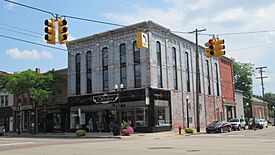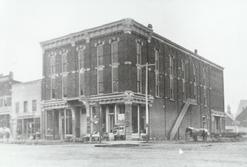Howell Opera House facts for kids
|
Howell Opera House
|
|
|
U.S. Historic district
Contributing property |
|

Howell Opera House in July 2023
|
|
| Location | 123 W. Grand River Avenue Howell, Michigan |
|---|---|
| Built | 1880 |
| Part of | Howell Downtown Historic District (ID86003363) |
Quick facts for kids Significant dates |
|
| Designated CP | February 27, 1987 |
The Howell Opera House is a very old and special building in Howell, Michigan. It's called an opera house because it was built for shows and performances. This building is so important that it's listed as a historic place by the Michigan State Historic Preservation Office. It's also part of the Howell Downtown Historic District on the National Historic Register. This means it's officially recognized for its history and unique style.
Contents
A Look Back: History of the Opera House
The Howell Opera House is a beautiful building designed in the Victorian style. It was built to hold many people, about 1,000 at a time! A talented architect from Detroit, Almon C. Varney, drew up the plans. The building cost about $10,000 to construct.
Building Begins in the 1880s
Construction started in 1880 with contractors Hunter and Holmes. The doors first opened to visitors on December 30, 1881. You can find this historic building at 123 W. Grand River.
A Hub for Community Events
This opera house was more than just a place for plays and music. It was a central spot for the town. Many local events happened here, like high school graduation ceremonies. For a short time in 1889, it even served as the home for the Livingston County Circuit Court.
Early Owners and New Uses
The Stair Brothers, E.D. and Orin, first owned the Howell Opera House in 1884. Later, in 1893, Arthur Garland bought the theater. He used part of the building to make custom-tailored suits.
Closing Its Doors for Shows
In 1923, the fire marshal closed the building. This meant it could no longer be used for entertainment. For over 70 years after that, the Howell Opera House was used as a storage space for a local hardware store.
Bringing It Back: Renovation Efforts
In 2000, the Livingston Arts Council bought the Howell Opera House. Their big dream was to bring it back to life as a theater once again.
Starting the Restoration Work
Renovations began in 2001. It was a slow start because they needed more money to fund the project. By 2007, the first part of the restoration plan was finished.
What Was Renovated?
So far, only the first floor of the Opera House has been fully renovated. This work included making the floors and walls look new again. They also added new stairways. There are still plans to restore the second floor, which has the stage and balcony.
New Life for the First Floor
Today, the renovated first floor of the Opera House is a busy place. People can rent it for special events. It's a popular spot for weddings and parties!


